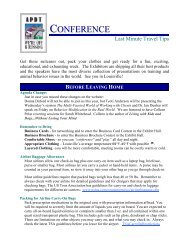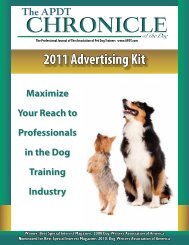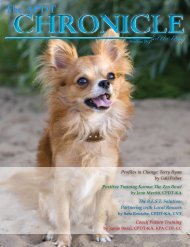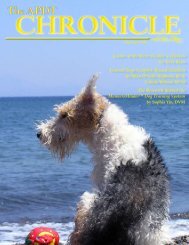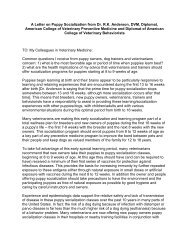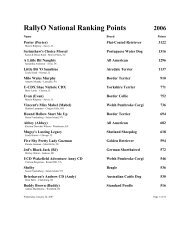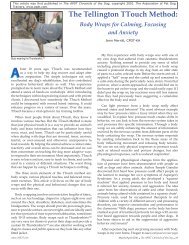of the Dog - Association of Pet Dog Trainers
of the Dog - Association of Pet Dog Trainers
of the Dog - Association of Pet Dog Trainers
You also want an ePaper? Increase the reach of your titles
YUMPU automatically turns print PDFs into web optimized ePapers that Google loves.
Value Title<br />
100%<br />
80%<br />
60%<br />
40%<br />
20%<br />
Figure 6: Message Behaviors<br />
a major dog communication method with both cospecifics<br />
and humans. 17 Similarly, touch was <strong>the</strong> overall lowest<br />
ranking behavior at a measly 3% but 26% <strong>of</strong> <strong>the</strong> behaviors<br />
making up <strong>the</strong> modeling category and 13% <strong>of</strong> <strong>the</strong> complex.<br />
The most popular behavior, vocal, was totally absent from<br />
reported modeling behaviors. Instead action behaviors<br />
topped <strong>the</strong> modeling mix.<br />
Message Categories (Figure 4)<br />
General requests (i.e. walks, help) topped <strong>the</strong> humaninterpreted<br />
messages closely followed by attention seeking<br />
and <strong>the</strong> inevitable potty urges. Affection and alert messages<br />
closely matched. Seemingly less popular messages were<br />
those for play, avoidance, and greet with permission seeking<br />
and beg <strong>the</strong> least popular. In Figure 6, I summarize each<br />
message’s most frequent and less frequent behaviors as<br />
well as behaviors not used for specific messages. Potty<br />
and general requests produced <strong>the</strong> most varied behavior<br />
assortment. <strong>Dog</strong>s in this survey preferred action behaviors<br />
www.APDT.com<br />
Figure 4: Message Mean Baseline<br />
4%<br />
5%<br />
3%<br />
5%<br />
2%<br />
5%<br />
18%<br />
11%<br />
10%<br />
21%<br />
14%<br />
Message Baseline<br />
O<strong>the</strong>r (4%)<br />
Play (5%)<br />
Permission (3%)<br />
Greet (5%)<br />
Beg (2%)<br />
Avoidance (5%)<br />
Attention (18%)<br />
Alert (11%)<br />
Affection (10%)<br />
Request (21%)<br />
Potty (14%)<br />
Message Most Frequent Behavior(s) Less Frequent Behavior(s) No Behavior(s) in Message<br />
Potty vocal, modeling, touch, action,<br />
gesture<br />
complex gaze<br />
Request modeling, action, complex vocal, touch, gaze all represented<br />
Affection vocal gesture, action complex, gaze, modeling, touch<br />
Alert complex vocal, action, gaze modeling. gesture, touch<br />
Attention vocal, gesture complex action, gaze, modeling, touch<br />
Avoidance action gesture, modeling complex, gaze, touch, vocal<br />
Beg gesture none all o<strong>the</strong>rs<br />
Greet vocal none all o<strong>the</strong>rs<br />
Permission gaze gesture action, complex, modeling,<br />
touch, vocal<br />
Play action gaze complex, gesture, modelling,<br />
touch, vocal<br />
O<strong>the</strong>r modeling gaze, vocal action, complex, gesture, touch<br />
to request play while gaze was <strong>the</strong> behavior <strong>of</strong> choice<br />
when <strong>the</strong>y sought permission and gesture for a beg. <strong>Dog</strong>s<br />
used mostly vocal behaviors such as purring, low growls,<br />
moans, sighs and o<strong>the</strong>r s<strong>of</strong>t sounds to indicate affection.<br />
Alert messages involved complex behaviors, such as vocal,<br />
action, gaze, and gestures. Humans identified most alerts<br />
not as warnings but as announcing visitors or identifying<br />
specific situations.<br />
Variable Summary<br />
AKC Groups<br />
Herding dogs represented 40% <strong>of</strong> <strong>the</strong> groups so <strong>the</strong>ir<br />
behavior results closely matched both <strong>the</strong> overall behavior<br />
and message categories. Only sporting and herding breeds<br />
included all seven behavior categories while <strong>the</strong> hound<br />
and toy groups had <strong>the</strong> least, most likely due to <strong>the</strong>ir<br />
limited sample size.<br />
Action behaviors produced a few surprises. Hounds,<br />
non-sporting and sporting breeds posted <strong>the</strong> most action<br />
behaviors, but <strong>the</strong> normally feisty terriers scored no action<br />
responses nor did <strong>the</strong> working dogs with high-energy<br />
herding dogs only above <strong>the</strong> baseline. True to <strong>the</strong>ir digging<br />
acumen, terriers proved king <strong>of</strong> gestures. Working breeds<br />
and mixes gestured just above <strong>the</strong> baseline. Non-sporting<br />
dogs showed no gesture behaviors. Sporting dog scored<br />
considerably and, surprisingly, below <strong>the</strong> gesture baseline<br />
yet <strong>the</strong>se breeds along with herding dogs displayed at<br />
least twice <strong>the</strong> touch baseline behaviors.<br />
Hounds obviously proved <strong>the</strong>ir vocal mettle but <strong>the</strong><br />
diverse non-sporting breeds matched <strong>the</strong>m with 50% <strong>of</strong><br />
<strong>the</strong>ir behaviors as vocal and <strong>the</strong> terriers followed close<br />
behind. Sporting breeds seemed <strong>the</strong> least vocal which may<br />
relate to <strong>the</strong>ir need stay quiet in <strong>the</strong> field. Non-sporting<br />
dogs also used <strong>the</strong>ir eyes to signal <strong>the</strong> most, three times<br />
above <strong>the</strong> gaze baseline. Sporting dogs and working dogs<br />
gazed half as much as <strong>the</strong> non-sporting breeds. However,<br />
Border Collies may feel slighted since herding dogs used<br />
gaze only 3% <strong>of</strong> <strong>the</strong> time.<br />
Working and sporting dogs excelled at <strong>the</strong> more complex<br />
behaviors. Terriers and <strong>the</strong> sample-limited toys and<br />
hounds demonstrated no complex behaviors in this survey.<br />
However, terriers mastered modeling behaviors at a rate<br />
well above average compared to o<strong>the</strong>r breed groups in <strong>the</strong><br />
survey. Working, mixed, and sporting breeds came close<br />
to <strong>the</strong> average, while non-sporting breeds demonstrated<br />
no complex or modeling behaviors.<br />
As <strong>the</strong> owner <strong>of</strong> a quick-witted Sheltie and hyperactive<br />
Malinois, I thought herding dogs would rank higher for<br />
<strong>the</strong> more complicated or action-oriented behaviors. They<br />
ranked close to <strong>the</strong> average for modeling and below for<br />
complex behaviors, with <strong>the</strong>ir action score only slightly<br />
higher than <strong>the</strong> category average. Herding dogs also were<br />
one <strong>of</strong> two groups to show avoidance and beg messages,<br />
both slightly above <strong>the</strong> average. Herding dogs scored<br />
lowest in affection messages. Working dogs sent <strong>the</strong> most<br />
Valentines (nearly four times <strong>the</strong> average) with sporting<br />
and mixes cuddling up with average [continued on next page]<br />
November/December 2008 w The APDT Chronicle <strong>of</strong> <strong>the</strong> <strong>Dog</strong> w 27<br />
Creative Canine: Original Intentional Canine-to-Human Communication



